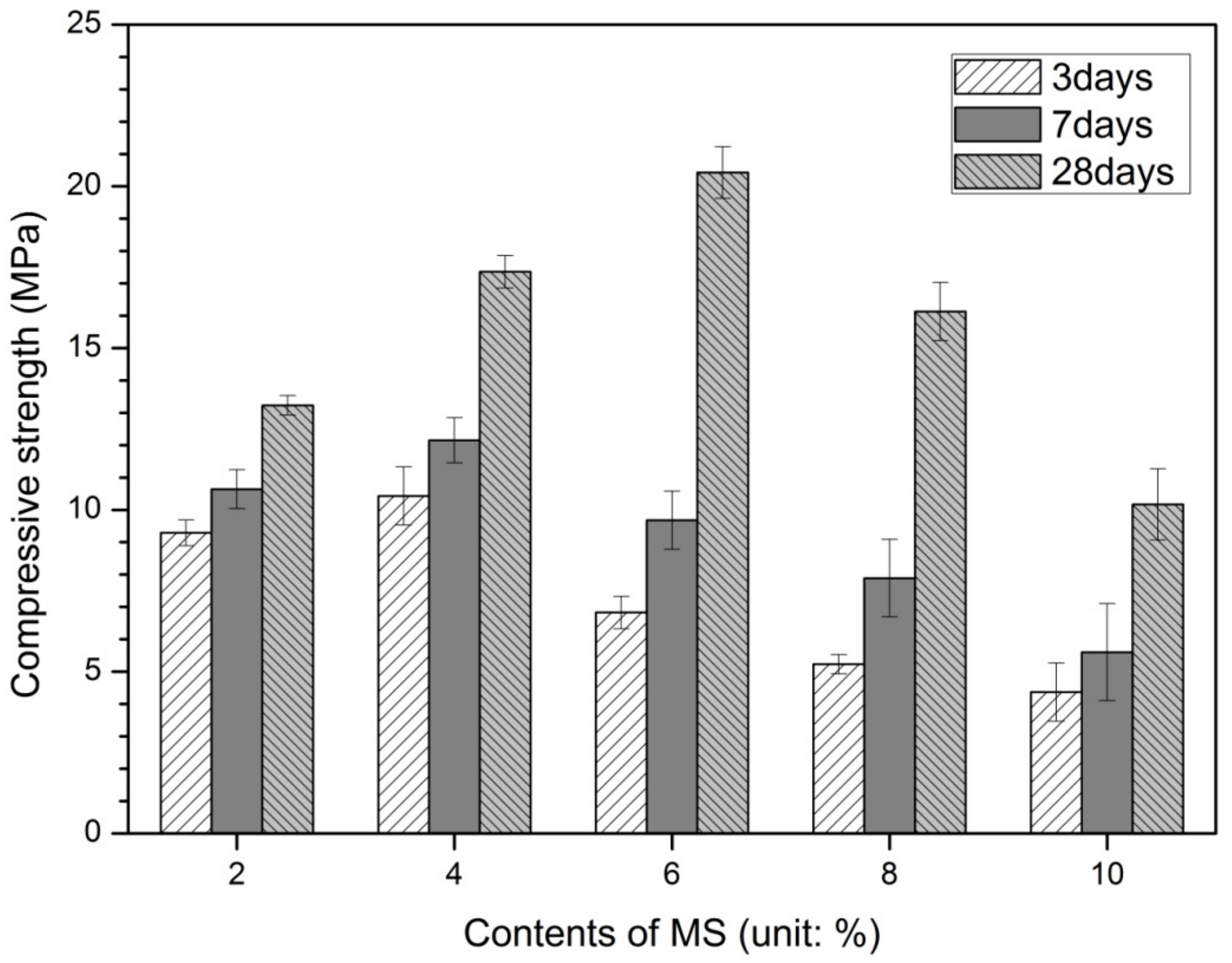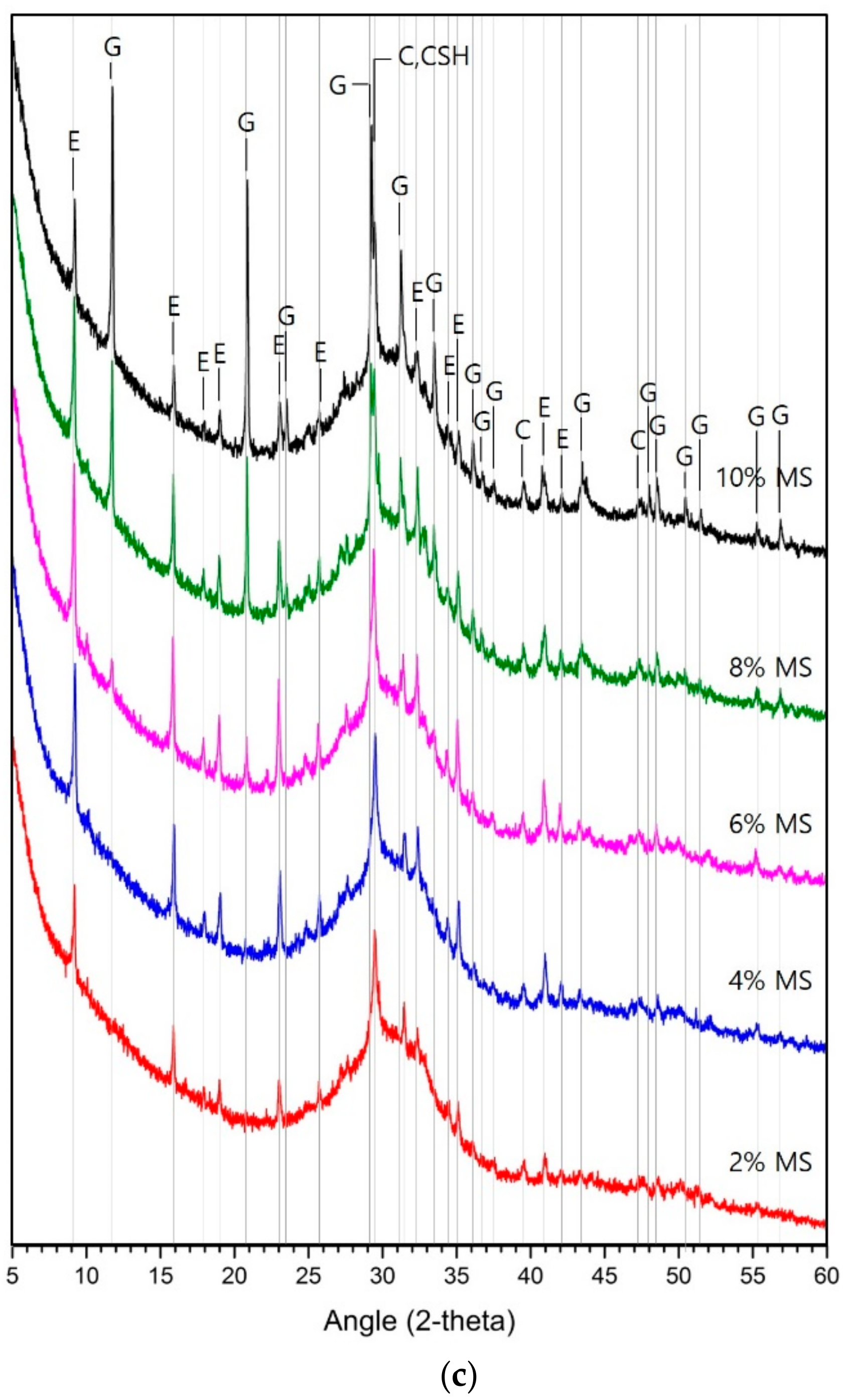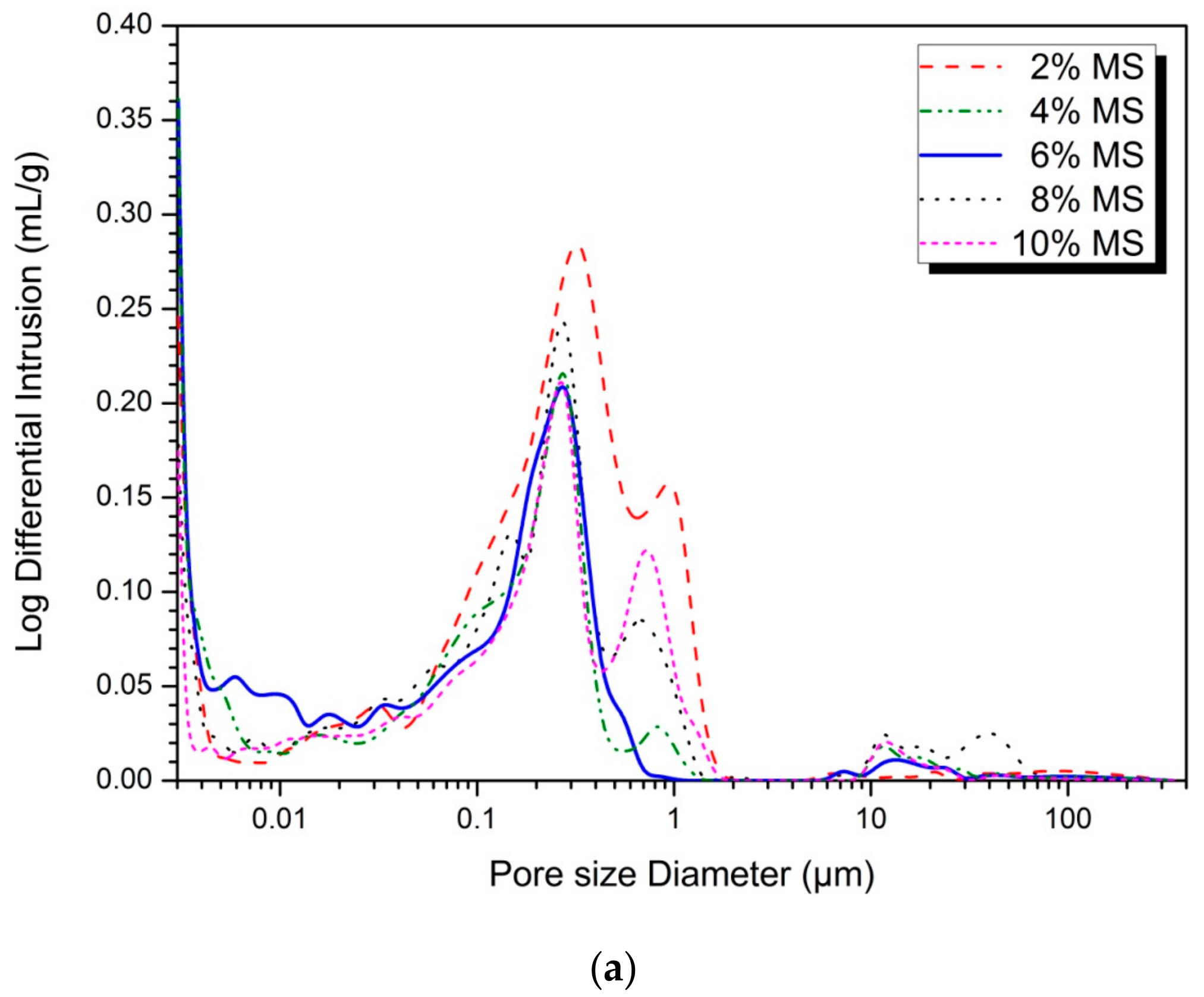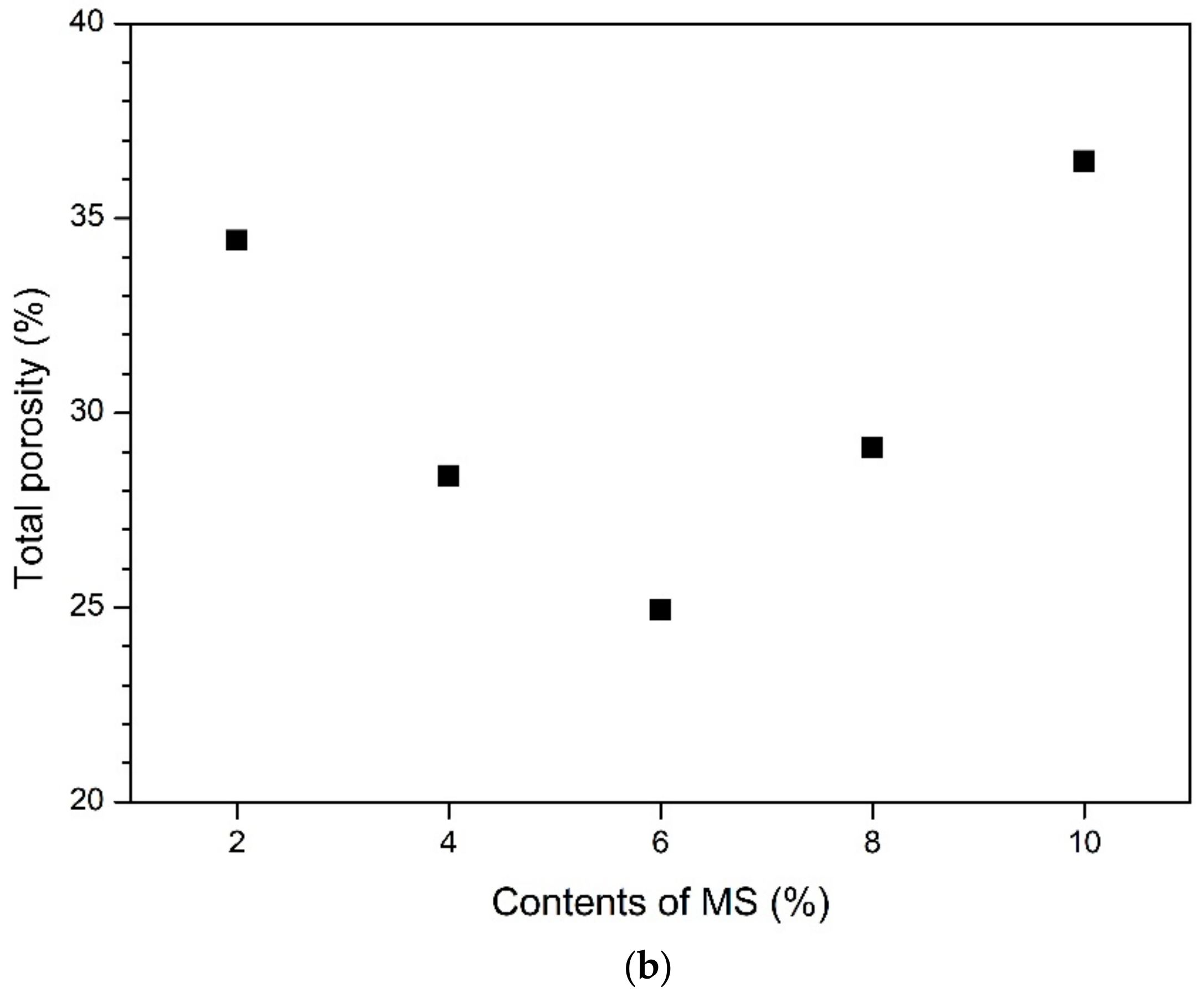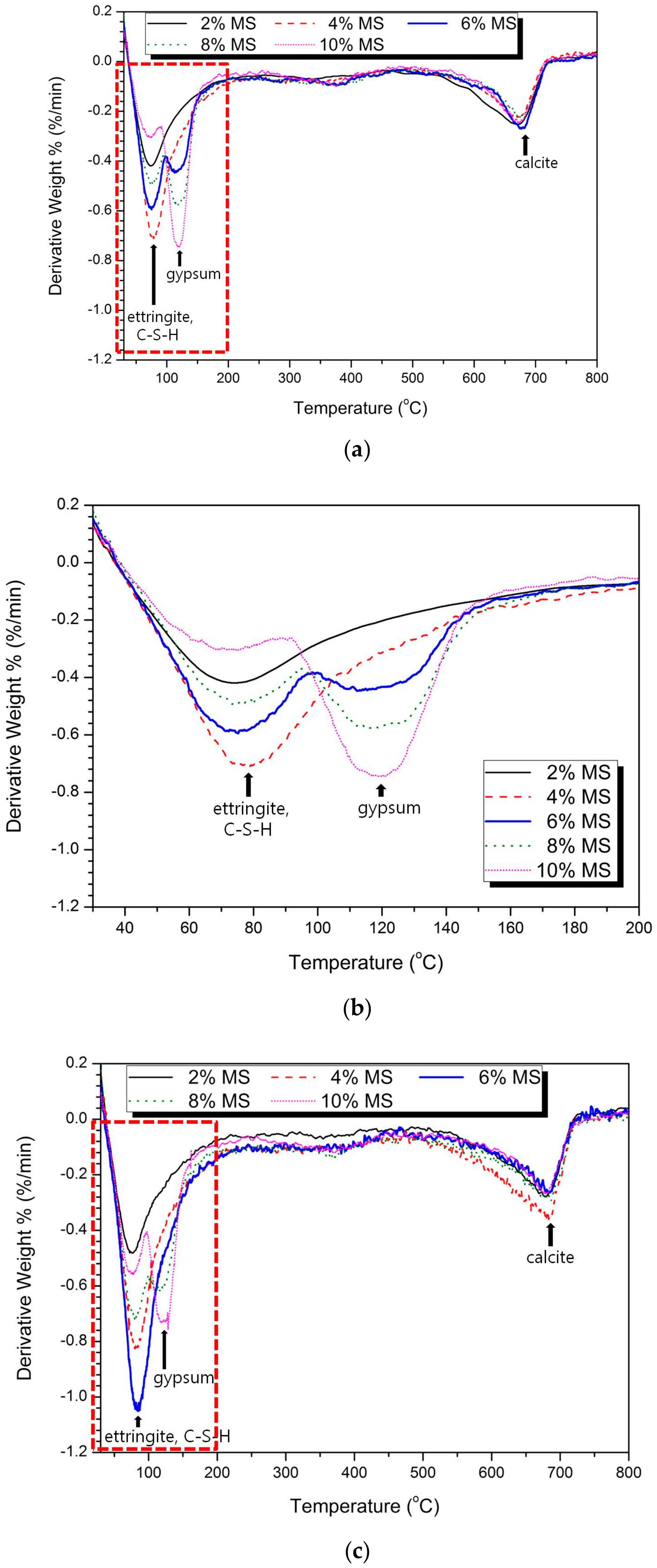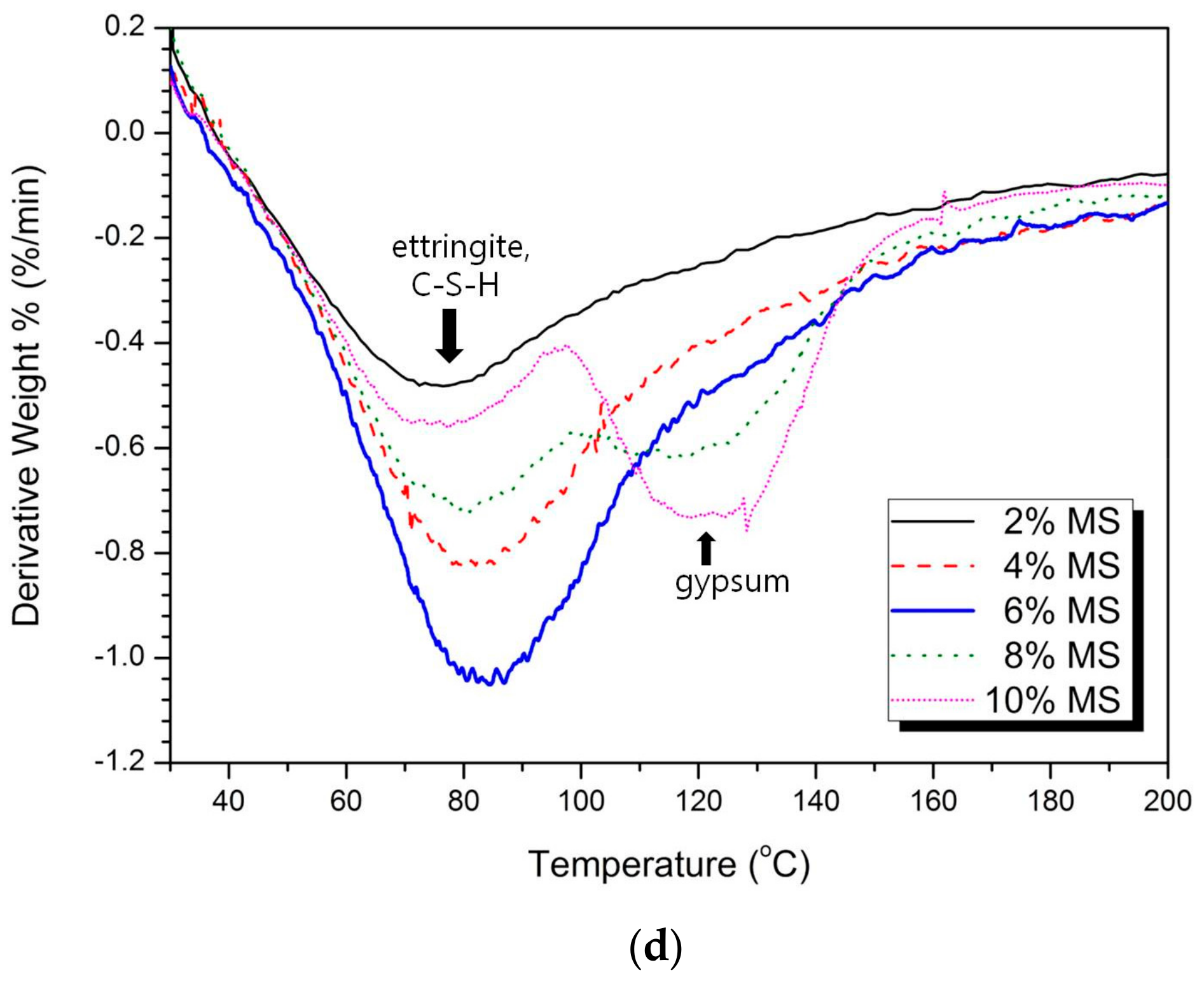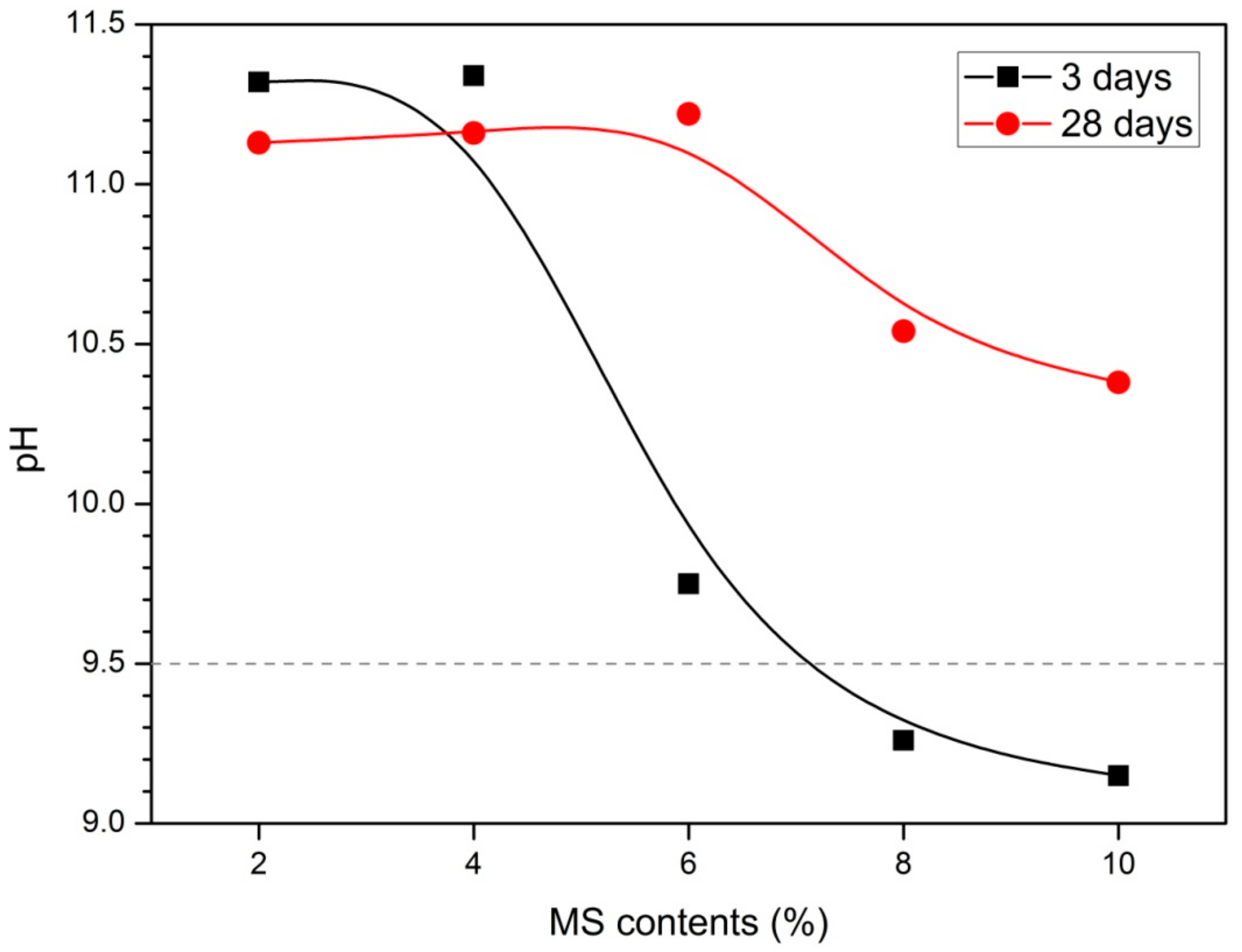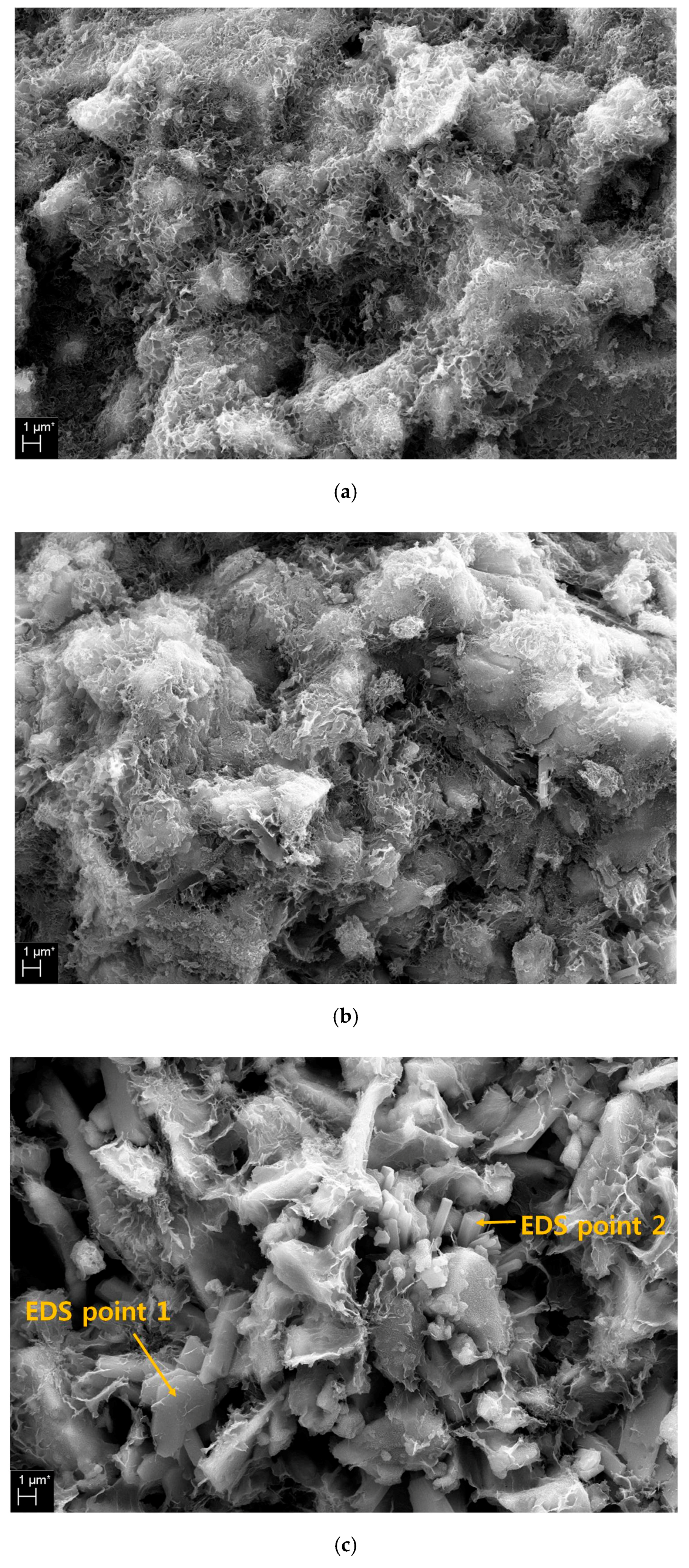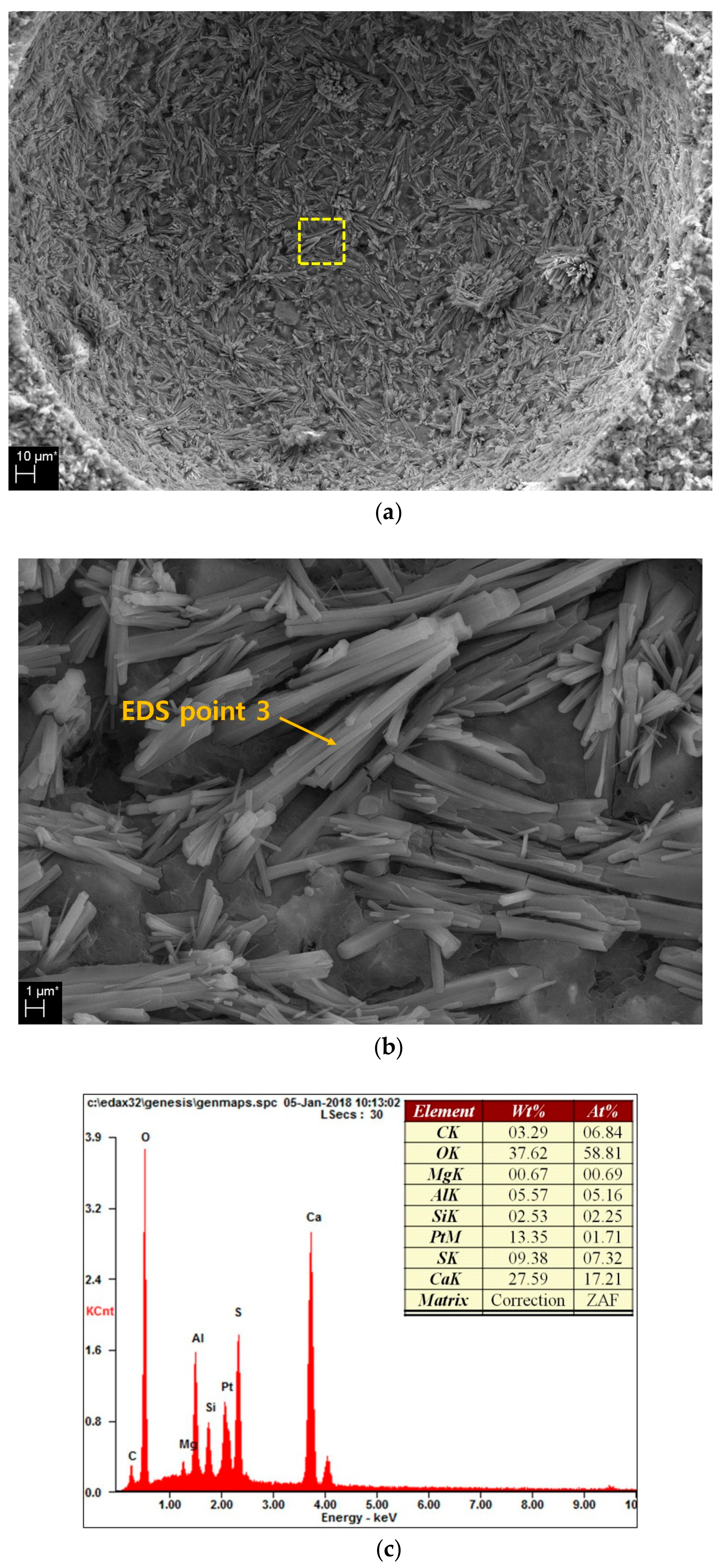3.1. Compressive Strength
Figure 1 shows the measured compressive strength according to the MS concentration and age. Regardless of the amount of MS, the compressive strength increased with age from 3 to 28 days.
The highest values of compressive strength were found at a MS contents of 4% (10.43 MPa), 4% (12.15 MPa) and 6% (20.43 MPa) respectively for 3 days, 7 days and 28 days of curing, and then they decreased with the increasing of the MS contents, showing the lowest compressive strength value at 10% MS (in
Figure 1). As shown in
Figure 1, the highest compressive strengths at 3 days, 7 days, and 28 days were observed in the contents of a particular MS. These results indicate that the compressive strength does not increase linearly with increasing MS contents. The highest values of compressive strength increased with the age, for all the MS contents, as expected [
3,
5,
18].
Rashad et al. [
16] reported that the compressive strength of this study. Rashad et al. [
16] performed sodium sulfate activation on two types of slag with different fineness of 2500 cm
2/g and 5000 cm
2/g. Sodium sulfate is 2.29% and 6.87% of the weight of slag, which means 1% and 3% of Na
2O equivalent by mass of slag, and the water-to-binder ratio (w/b) is 0.3. The higher the fineness of the slag, the higher the compressive strength at the same sodium sulfate concentration. Except for the 3 days compressive strength of M2, the strengths of 3, 7 and 28 days of the samples were higher than the values of this study. As the concentration of sodium sulfate increased from 2.29% to 6.87%, the compressive strength increased regardless of slag fineness. However, this study shows low initial compressive strength despite increasing MS concentration. It also showed the highest compressive strength at a specific MS concentration. The fineness of slag used in this study is in the middle of the two kinds of slag fineness used in the Rashad et al. [
16] experiment. However, regardless of the fineness characteristics, MS did not show a significant contribution to the improvement of compressive strength due to lower activation of slag than sodium sulfate.
Melo Neto et al. [
20] reported the compressive strength results of mortar test using 2% lime + 6% gypsum on slag mass. The ratio of binder:quartz sand:water was 1:2:0.48. In the compressive strength of this study, the 3 and 7 days strengths were higher than all MS concentrations. However, the compressive strength of 28 days showed a slight difference than that of 6% MS. Park et al. [
22] reported the results of replacing gypsum with 10% and 15% of the slag mass. All slag used in the experiment basically substituted 5% CaO. All mixtures have a constant w/b of 0.4. The 10% gypsum shows higher compressive strength than 15% concentration. In addition, 10% and 15% gypsum samples showed higher compressive strength than MS at 7 and 28 days. In the case of gypsum, there was a specific concentration with the highest compressive strength. In this study, the highest compressive strength occurred at 4% at 3 and 7 days and 6% MS at 28 days. Park et al. [
22] reported that when the concentration of gypsum increased from 10% to 15%, the change in pore structure (increase of total porosity) due to the expansion of unhydrated gypsum was the cause of the decrease in strength.
Haha et al. [
27] used NaOH as 3.77% of the slag mass and water glass as 10.0% to have the same Na
2O content. Here, M8 means 7.7% of MgO contents, 10.5% of M11, and 13.2% of M13 among the components constituting slag. The w/b ratio is 0.4 with paste. Regardless of the composition ratio of MgO, the 3 days strength of the sample using water glass as the activator is less than the 3 days compressive strength of the samples using MS. However, the compressive strength of 7 and 28 days increased significantly, higher than that of MS. On the other hand, NaOH showed similar range of 3 days strength compared to MS, and the compressive strength of 7 and 28 days increased slightly compared to MS. Compared with NaOH, water glass had a smaller compressive strength at early-age strength (3 days) but a sharp increase in strength after 7 days.
The compressive strength values of alkaline activated slag cement using the same mixed activation of 5% NaOH + 5% Na
2SiO
3 and 10% NaOH + 10% Na
2SiO
3 were measured higher than MS [
28]. Both 5% and 10% activators showed higher strength values than MS, and 10% activator showed better compressive strength value than 5%. This is consistent with the findings from previous studies on AASC that increasing the activator concentration increases compressive strength. In particular, mixed activators of sodium hydroxide and sodium silicate show a higher strength-improving effect than the use of each separately.
Comparing the mechanical properties of MS with other types of activators shows that MS has relatively low slag activation effect. In the previous study on AASC, high compressive strength was obtained from experiments in which sodium silicate was mixed with NaOH and KOH at concentrations of 6, 8 and 10 moL [
23]. In general, it has been reported that the use of a mixture of sodium silicate and hydroxide-based activation can achieve high compressive strength. In other studies where 1% Na
2O equivalent of Na
2SO
4 was used, an increased strength with age was also reported [
18]. In an AASC study in which gypsum was used at 2% and 4% by slag mass [
19], the compressive strength increased with the amount of gypsum. As reported by Wang et al. [
29], the early compressive strength of AAS mortars activated with sodium sulfate is lower than that with other activators such as Na
2CO
3, NaOH and water-glass (sodium silicate). The recorded compressive strengths of mortars activated with 2 M Na
2SO
4 are 1.2, 5.1, 10.2 and 20 MPa at the ages of 1, 3, 7 and 28 days, respectively. These compressive strengths were lower than those obtained with other activators, particularly the early-age strength. In previous studies, a relatively low initial strength of AASC has been reported when using a sulfate as the activator [
15,
18,
21,
25].
The strength of AASC using sulfate as an activator showed relatively low initial and late strengths as compared with AASC using sodium hydroxide or sodium silicate as an activator. These low strength properties were also confirmed in this study using MS.
3.2. Hydration Products
Figure 2 shows the results of XRD analysis according to the MS content for each age. The representative reaction products were ettringite, gypsum, calcite and calcium silicate hydrate (C-S-H). This is consistent with the reactants shown in AASC studies where Na
2SO
4, CaSO
4 or gypsum (CaSO
4·2H
2O) was used as the activator [
15,
22,
30].
As age increases, the ettringite and C-S-H peaks increase and the gypsum peak decreases. Ettringite and C-S-H are representative hydration products of AASC using sulfate as an activator. Therefore, the increase of ettringite and C-S-H peak means the hydration of GGBFS. From the compressive strength results shown in
Figure 1 and the XRD results shown in
Figure 2, the MS affects the hydration of GGBFS, but its reactivity can be assumed to be slow. However, as the concentration of MS increases, the C-S-H gel peak decreases slowly. Pan et al. [
14] reported that as the SO
4 increased, the C-S-H gel slowly disappeared and a significant amount of extensive ettringite was produced. Therefore, in this study using MS as an activator, the change of ettringite peak is clearly confirmed, but the change of C-S-H gel peak is not clear. In particular, as the concentration of MS increases, the C-S-H gel peak tends to decrease slightly. This is consistent with Pan et al. [
14] report mentioned earlier. This slow hydration reactivity has already been reported in previous studies using sulfate such as Na
2SO
4 or CaSO
4. Sahin et al. [
25] showed that adding 10% gypsum to slag resulted in a high compressive strength when cured at 80 °C, but an unreacted-gypsum peak was still observed. In the present study using MS, a gypsum peak was observed even after 24 h at 80 °C.
The main reactant of slag activated with Na
2SO
4 (sodium sulfate) is C-S-H with a low Ca/Si ratio and a significant degree of aluminium substitution, referred to as C-A-S-H [
15]. The main secondary reaction product has been identified as ettringite (3CaO·Al
2O
3·3CaSO
4·32H
2O) [
15,
16].
In previous studies on AASC using sulfate activators, it has been reported that the sulfate activator had an insufficient effect on the slag so that insufficient hydration of the GGBFS was achieved [
15,
21]. In the case of slag activated with Na
2SO
4, increasing the sulfate content increased the reactivity with the slag and led to a higher ettringite peak [
15]. However, the results of the present study show that the ettringite peak tends to increase up to a certain MS content and then decrease.
In
Figure 1, the maximum compressive strengths are found for 4% MS on day 3 [
Figure 2a] and day 7 [
Figure 2b] and with 6% MS on day 28 [
Figure 2c]. In
Figure 2, no gypsum peak is observed with up to 4% MS on days 3 and 7, and the highest ettringite peak is observed with 4% MS. However, from 6% to 10% MS, the gypsum peak increases sharply and the ettringite peak decreases sharply. At 28 d, no gypsum peak is observed until 6% MS, and the ettringite peak increases gradually, leading to the highest ettringite peak at 6% MS. The gypsum peak increases and the ettringite peak decreases from 8% to 10% MS. In
Figure 2a, the gypsum peak is very small up to 4% MS. Portlandite and ettringite peaks were gradually increasing up to 4% MS. However, the gypsum peak was rapidly increased at 6% MS. Moreover, portlandite and ettringite peaks start to decrease from 6% MS. In
Figure 2b,c, the MS content at which these changes occur is 4% and 6%, respectively. Therefore, the intensity of gypsum, portlandite and ettringite peaks change rapidly at 4% MS at 3 days, 4% MS at 7 days and 6% MS at 28 days. As shown in
Figure 1, the highest compressive strength occurred at the MS content where the peak change was abrupt. From the XRD results, the maximum compressive strength is greatly affected by the increase in ettringite and the decrease in gypsum.
Therefore, as the contents of MS increases, the amount of gypsum increases. The gypsum activates GGBFS and forms ettringite. Gypsum is a major source of sulfate ions. Activation of GGBFS elutes Ca
2+ and Al
3+ ions from GGBFS. In slag experiments with 5% and 10% substitution of gypsum, the increase of gypsum contents increased the gypsum peak and ettringite peak in XRD analysis [
22]. Therefore, gypsum affects the production of ettringite, but unhydrated gypsum is present between the hydration reactants, causing expansion and thus reducing compressive strength [
22]. In contrast, in the study using sodium hydroxide or sodium silicate as individual admixtures or blending, the main hydration reactant was C-S-H gel [
27,
28]. In their XRD analysis, gypsum and ettringite were not observed. This may be due to the presence of sulfate (sodium sulfate, calcium sulfate, and magnesium sulfate), which is not present in sodium hydroxide or sodium silicate. As a result, the use of hydroxide or silicate series as an activator shows a rapid activation reaction in the initial hydration of slag. On the contrary, sulfate showed a slow activation reaction and major reactants were different.
This process is repeated and affects the change of hydration products and compressive strength. Unreacted-MS was not found in samples exceeding the MS content where the highest compressive strength occurred. This may be because MS decomposes into gypsum and magnesium compounds in the hydration reaction stage. This phenomenon is similar to that reported by Mobasher et al. [
15], who detected no unreacted Na
2SO
4 in AASC activated with Na
2SO
4. The XRD analysis in
Figure 2, no hydration reaction containing magnesium was observed. Presumably, it is believed to exist as a hydrated reactant in amorphous form not measured by XRD.
MS is separated into Mg
2+ and SO
42− by mixing with the mixture. SO
42− activates slag particles to promote the elution of Ca
2+ ions to form gypsum. Gypsum forms ettringite from Ca
2+ and Al
2+ ions eluted from slag. From this reaction up to 4% MS contents, most of the gypsum is consumed to form ettringite (3CaO·Al
2O
3·3CaSO
4·32H
2O). Therefore, in the XRD analysis of
Figure 2, the gypsum peak was hardly observed until 4% MS contents. However, from contents exceeding 6% MS, more gypsum is formed than gypsum needed to form ettringite. As a result, excessively formed gypsum expands over time, increasing porosity and decreasing compressive strength.
3.3. Pore Structure
Figure 3 shows the pore size distributions and total porosities for different MS contents measured using MIP at 28 days. Although the true pore size distributions of the specimens might differ from the MIP results, as discussed in previous work [
31,
32], the MIP results are still useful for comparing the pore size distributions between the specimens.
Compared with the 6% MS sample with the highest intensity in
Figure 3a, the remaining MS concentration samples show an increase in pores between 0.3 and 2.0 μm. The pores in the range of 0.3–2.0 μm are decreasing gradually in order of 2% > 10% > 8% > 4% > 6% MS. It is also observed that pores of 10–100 μm increase at MS concentrations other than 6% MS sample. The 6% MS sample showed an increase in pore size of 0.01 μm or less. In the compressive strength results of
Figure 1, the magnitude of 28 days compressive strength increases in order of 10% < 2% < 8% < 4% < 6%. This increase in compressive strength is similar to the decreasing order of pore volume from 0.3 to 2.0 μm. Therefore, the amount of pores between 0.3–2.0 μm and 10–100 μm affects the change of compressive strength. The gypsum and ettringite shown in
Figure 2 are the factors influencing the size change of pore size. Park et al. [
22] reported that gypsum mixed with slag removed large pores (100 μm) and 0.1 μm pores because of the formation of fine ettringite and increased the strength by increasing 0.03–0.40 μm pores. The addition of excess gypsum also suggests that a large number of pores near 1 μm and pores with a size of 10–100 μm are generated to reduce the strength. This may be due to an expansion crack or a large pore between the relatively large re-precipitated gypsum crystals.
Figure 3b shows the total porosity of Park et al. [
22] and Kim et al. [
28] at 28 days. Park et al. [
22] noted that the 10% gypsum sample had the lowest total porosity and the highest compressive strength. The 15% gypsum sample showed lower total porosity than the 0% gypsum sample. The cause of this result was reported that excessive gypsum caused expansion inside the specimen, increasing porosity and decreasing compressive strength. A study by Kim et al. [
28] using 5% NaOH + 5% Na
2SiO
3 and 10% NaOH + 10% Na
2SiO
3 showed a sharp decrease in the total porosity of the 10% activator than 5%. Increasing the concentration of the activator promotes the formation of the hydration reactant and creates a dense structure, reducing the porosity. However, the sulfate-based activator is relatively slow in the hydration of the slag particles, delaying the formation of dense hydration reactants. As a result, the total porosity is higher than AASC using NaOH or Na
2SiO
3. However, since the factors affecting the total porosity are various, it is difficult to identify the clear tendency simply by the type and concentration of the activator. In recent studies, however, Na
2SiO
3 was found to have a more effective pore filling effect than NaOH [
33]. Analysis of pore structures by activators requires much further research.
Table 2 shows the distribution according to pore size smaller than 10 μm [
34]. The percentage of large-capillary pores decreases from 2% to 6% MS and increases from 8% to 10% MS. The percentages of medium-capillary pores and gel pores decrease from 8% to 10% MS after increasing from 2% to 6% MS. The 6% MS sample with the maximum compressive strength has the smallest percentage of large-capillary pores and the highest percentage of medium-capillary and gel pores. It is generally known that the presence of relatively large pores in a solid reduces its strength [
35]. The correlation between the strength results and the pore size analysis of
Figure 1 can be confirmed. The 10% MS samples with the lowest compressive strength showed the largest amount of large capillary pores and the least amount of gel pores. In contrast, the 6% MS sample has the smallest amount of large capillary pores and the largest amount of gel pores. The compressive strength was improved as the number of large capillary pores decreased and the number of gel pores increased. Therefore, it can be confirmed that MS affects the pore structure and compressive strength of the hydration reaction product. MS-activated AASC has an optimal amount of MS that produces the highest compressive strength.
3.4. Thermal Analysis
Figure 4 shows the thermal analysis (TG/DTG) results for the 3 d and 28 d samples. The TG/DTG analysis shows that the main reaction materials were ettringite and gypsum. These reactants correspond to the XRD results shown in
Figure 2.
In
Figure 4a,b, weight loss due to water loss of ettringite, C-S-H and calcite can be confirmed. The ettringite shows weight loss at 80 °C–130 °C [
36] or 110 °C–150 °C [
37]; C-S-H shows weight loss at 50 °C–200 °C [
38] or 90 °C–110 °C [
39], and gypsum shows weight loss at 80 °C–220 °C [
40] or 100 °C–200 °C [
41]. Calcite can be checked for weight loss at 665 °C–800 °C [
41]. Due to the fact that the typical temperature ranges for the decomposition of C-S-H, ettringite and gypsum are narrowly located, it is difficult to precisely estimate the amounts of these reaction products [
30]. However, because the amounts of C-S-H are similar between the samples (as concluded previously in the XRD analysis) and because the gypsum peaks near 144 °C are relatively small, the large peaks before 200 °C in
Figure 4 are attributed mainly to the formation of ettringite.
Figure 4b,d show a large peak at 50–200 °C in the DTG curve because of the decomposition of ettringite and the loss of the adsorbed/inter-layer water of C-S-H. In
Figure 4b, ettringite increases from 2% to 4% MS, with 4% MS yielding the maximum weight loss. However, the ettringite weight loss curve decreases sharply from 6% to 10% MS. Gypsum increases gradually from 2% to 10% MS with the highest weight loss. As shown in
Figure 2a, the largest ettringite peak is observed with 4% MS with the highest compressive strength, and the gypsum peak is hardly observed. However, from 6% to 10% MS, the ettringite peak decreases and the gypsum peak increases sharply. The results of the thermal analysis are also consistent with the tendency of the hydration products in the XRD.
In
Figure 4d, ettringite shows the maximum value with increasing weight loss until 6% MS and then decreases again to 10% MS. Gypsum increases gradually from 2% MS to the maximum weight loss at 10% MS. As shown in the XRD results in
Figure 2c, the largest ettringite peak is observed at 6% MS with the highest intensity, and the gypsum peak is hardly observed. However, from 8% to 10% MS, the ettringite peak decreases and the gypsum peak increases steeply. No untreated MS, brucite (Mg(OH)
2) or M-S-H gel was observed by thermal analysis.
3.5. pH Values
Figure 5 shows the results of pH measurements at 3 and 28 days. The 3 days samples had the highest value of pH 11.34 at 4% MS, and the 28 days samples had the highest value of pH 11.22 at 6% MS. The highest compressive strength was measured in the MS contents with the highest pH. This is clearly seen in comparison with the compressive strength results in
Figure 1. At 3 days 0% to 4% MS was measured in the range of pH 11.0 to 11.5, but contents above 6% MS showed values less than pH 10.0. This decrease in pH value is clearly seen as the contents of MS increase. In particular, 6% MS shows a sharp decrease in pH compared to 4% MS. At 28 days, pH values from 0% to 6% MS were measured in the 11.0–11.5 range. However, 8% and 10% MS were measured to be less than pH 11.0 and 10% MS showed the lowest pH value.
The pH of the activator plays an important role in the hydration of slag. Song et al. [
42] suggested that a pH higher than 11.5 is required for the hydration of slag to be activated effectively. It was also reported that the slag was not hydrated at pH lower than 9.5. Puertas et al. [
43] noted that the activation process is delayed at low pH below 12. In addition, previous studies have reported that C-S-H gels do not form in environments with pH lower than 9.5 [
42,
43,
44]. Therefore, at low pH (<9.5), a dense matrix is not formed, which affects high porosity and low compressive strength. All samples in this study at 3 and 28 days showed pH values below 12. In particular, pH values of less than 9.5 were measured for 8% and 10% MS at the 3 days sample. The pH lower than 11.5 causes the compressive strength to be low due to insufficient activation of slag. The hydration delay of slag affects not only the initial compressive strength but also the late compressive strength at 28 days. Although 6% MS at 28 days has the highest intensity value, it shows below 25 MPa. This is lower than the compressive strength results of activated slag experiments using sodium sulfate of Rashad et al. [
21] as an activator and cured at 40 °C. In the results of Rashad et al. [
21], pH was observed between 12.0 and 12.5 regardless of slag fineness. Compared with the experiments of Rashad et al. [
21], this study showed a low pH despite higher 24 h curing temperature (80 °C) and higher MS contents (~10%). MS is thought to have lower activation capacity than sodium sulfate.
Low activation of MS delays hydration of slag. Therefore, other methods may need to be added along with MS to improve the activation of slag. For example, the addition of activators, increased concentrations, higher curing temperatures and mixing of different admixtures should be considered.
3.6. Microstructure
Figure 6 shows SEM images of the 28 d samples with 2%, 6% and 10% MS.
Figure 6a,b shows no significant difference in the SEM images of the 2% and 6% MS samples. The pores are visible and can be seen covered with hydration products. However, the 10% MS sample shown in
Figure 6c shows a very rough surface, unlike the 2% and 6% MS samples. There are a number of pores, unreacted GGBFS particles and some hydration products on the observed surface.
In particular, EDS analysis was performed for ‘EDS point 1’ and ‘EDS point 2’ in the 10% MS sample.
Table 3 shows the results of EDS analysis for EDS points 1 and 2 in
Figure 6. ‘EDS point 1’ is a polygonal plate type and EDS analysis result is gypsum. ‘EDS point 2’ is identified as ettringite by EDS analysis with a short bar shape.
In
Figure 1, 10% MS with the lowest compressive strength values was able to identify multiple pores, few hydration products and gypsum through SEM image observation. The SEM images show that the coarse crystals of gypsum or ettringite produce porous matrices because of the excessive addition of MS. This is similar to a previous study in which excess gypsum concentration formed a coarse porous matrix by gypsum or ettringite [
22].
However, at the optimum MS concentration, strength enhancement by ettringite and gypsum can be obtained. The growth of ettringite and/or gypsum might cause two opposite effects for the strength development at an early reaction age. First, when ettringite and/or gypsum crystals grow appropriately in the pore spaces, this crystal growth might result in a pore-size-refining effect that promotes strength development. Second, however, if these crystals grow too much in the pores at an early reaction age, the overall matrix could expand and cause micro-cracks, which are probably the micro-cracks or pores seen in
Figure 6c [
22]. Therefore, the low compressive strength with 10% MS can be explained by the abundant presence of gypsum and the scarce presence of ettringite noted in the XRD and TG/DTG analyses. As noted in the MIP results, a high content of MS increases the number of pores around 1 μm and 10–100 μm. This can be explained by the excessive expansion of gypsum or ettringite as described above.
Figure 7a shows the hydration reaction material generated in the pores of the 6% MS sample. Numerous hydration reaction materials are generated inside the pores.
Figure 7b shows an enlargement of the yellow dotted rectangle in
Figure 7a, wherein a long bar-shaped material can be observed. An EDS analysis of one of these materials (‘EDS point 3′) is shown in
Figure 7c. The result is ettringite, which is the hydration reaction material noted in the XRD and TG/DTG analyses and is also the substance noted to decrease the pore size and amount in the MIP results.
